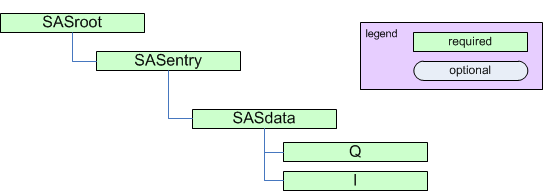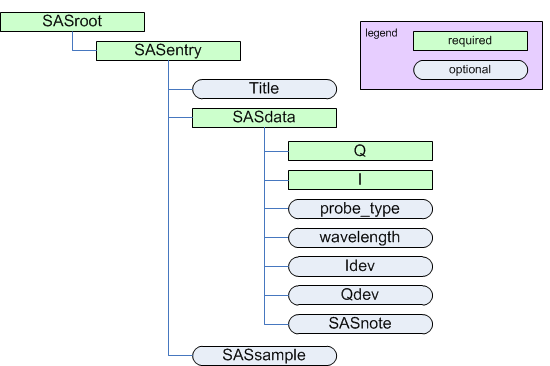Table Of Contents
Previous topic
Next topic
Metadata of the canSAS2012 data format
This Page
Quick search
Enter search terms or a module, class or function name.
Describe the structure of data to be presented for small-angle scattering analysis. Make the structure sufficiently general that it may be used for analysis of any form of reduced SAS data.
The hierarchical structure of the canSAS standard has been designed to be compatible with the NeXus data format.
The least amount of information necessary for meaningful small-angle scattering analysis is the presentation of the \(I(Q)\) SAS data. In the canSAS standard, this data is presented within a SASdata group (holding the data from a single experiment), inside of SASentry group (holding the data from a single sample), inside of a SASroot group (holding one or more experiments).
Note
It is recommended to store more metadata than this absolute minimum standard shows. See the section Minimum content recommended for reduced SAS data for more details.

Absolute minimum requirement for analysis of SAS data.
Alternatively, this may be shown using a more condensed notation, as:
1 2 3 4 5 6 7 | SASroot
SASentry
SASdata
@Q_indices=0
@I_axes="Q"
I: float[]
Q: float[]
|
It is recommended that instruments provide at least the information described in this section to satisfy the needs of data analysis and visualization software.

Minimum content recommended for reduced SAS data.
1 2 3 4 5 6 7 8 9 10 11 12 13 14 15 16 | SASroot
SASentry
Title: string
SASdata
@Q_indices=0
@I_axes=Q
I: float[]
Q: float[]
probe_type: string
wavelength: float (or possibly float[])
Idev: float[]
Qdev: float[]
SASnote
anything: string, float, float[], ...
SASsample
name: string
|
Caution
re-write from this point downward on this page
derived from original 1D format, attributes have changed
Caution
needs full write-up
derived from original 1D format, content and attributes have changed
Caution
needs full write-up
SASentry groups have several attributes:
| @name: | Text that describes this group. Must conform to the naming standard <naming standard> and must be unique within a SASentry group. Such as: @name="sasentry01"
|
|---|---|
| @version: | Describes the version of the canSAS standard used to write this data. This must be a text (not numerical) representation. Such as: @version="1.0"
|
different use from original 1D format, refers to a single reduced data set that can be represented thus (such as from one detector)
SASdata groups have several attributes:
| @name: | Text that describes this group. Must be unique within a SASentry group. Such as: @name="sasdata01"
|
|---|---|
| @I_axes: | A string array that describes the names of the data objects that correspond to the indices of the I data object. Such as: @I_axes=Temperature,Time,Pressure,Q,Q
|
| @Q_indices: | Array that describes which indices (of the \(I\) data object) are used to reference the Q data object. The items in this array use zero-based indexing. Such as: @Q_indices=1,3,4
which indicates that Q requires three indices from the \(I\) data object: one for time and two for Q position. |
| @Mask_indices: | Array that describes which indices (of the \(I\) data object) are used to reference the Mask data object. The items in this array use zero-based indexing. Such as: @Mask_indices=3,4
which indicates that Q requires two indices from the \(I\) data object for Q position. |
To indicate the dependency relationships of other varied parameters, use attributes similar to @Mask_indices (such as @Temperature_indices or @Pressure_indices).
derived from original 1D format, content and attributes have changed
Caution
needs full write-up
(string) Title of this SASentry. Optional attribute: name={short-Run-identifier}. Example:
Glassy Carbon C4 12keV
Storage container [1] with numerical data for analysis or any kind of metadata. All data objects have attributes, some required, some optional. The name chosen for each data object must adhere to the naming standard described below.
| @size: | (only for implementations that do not support that natively) Number of items in this data object. If the array is multi-dimensional, then the length of each index is reported individually. Such as: size="100,512"
describes a 2-D array of 100 rows and 512 columns. Some implementations like HDF5 provide native support for this (i.e. shape), in with case size should not be used. |
|---|
| @units: | (required for all numerical objects) Engineering units of this data object. Use the Unidata UDunits [2] specification as this is compatible with various community standards. |
|---|
| @uncertainty: | (optional for numerical arrays) Name of the data object (in this SASdata group) that provides the uncertainty to be used for data analysis. |
|---|
The names for data objects should follow a standard convention that starts with a letter (upper or lower case) and then a sequence composed of letters, numbers, and/or “_”. The length of the name is limited to no more than 63 characters (imposed by the HDF5 rule for names).
This standard convention for object names may be described by this regular expression:
[A-Za-z][\\w_]*
A special case discussed at canSAS2012.
Requires a named subdirectory below SASdata to contain the supplementary data. The name of the subdirectory is given in an attribute of the data object.
Contents:
Footnotes
| [1] | Such as text, a scalar, or an array. HDF5 calls this a dataset, Not a folder or a group or an object that contain other objects. |
| [2] | The UDunits specification also includes instructions for derived units. |